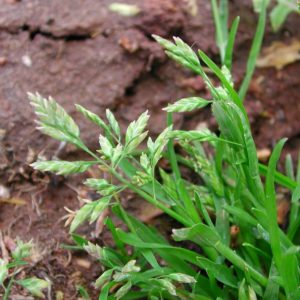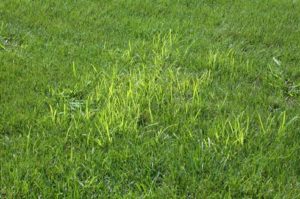Feb
Annual Weed Control and Your Lawn
With the recent rise in temperatures and a little moisture you have likely seen some weeds pop up even if you had put down a pre-emergent in the fall. We have hit the end of the window where the fall application will control the weeds. It is now time to control the weeds that have snuck through your barrier and to put down a control for the summer annuals.
Let us start with controlling the weeds that have made their way through your turf. There are a couple different types of weeds to treat. Before we can give you chemicals to spray its important to recognize the type of grass you’re treating. I will put the recommendations down for a dormant turf lawn and one that has been overseeded with perennial ryegrass for the winter. If you did not overseed in the fall you will follow the dormant turf guidelines. My recommendations will be for bermudagrass so if you have paspalum or St. Augustine make sure you read the herbicide label prior to applying and follow the correct rate. These are usually different than bermudagrass.
Dormant Turf
If you let your Arizona and California lawn go dormant for the winter, it is starting to see a little life now with the warmer temperatures. You will not see any growth until the soil temperature reached 64 degrees which is usually in April, but your lawn will green up in color in March.
First step will be to clean up your lawn by mowing any debris and dead material off the top. This is not scalping the lawn, just get a good clean up. Next step will be to treat any broadleaves or grassy weeds that may have popped through your turf. For broadleaves you can apply 2,4-D and grassy weeds such as poa annua or volunteer ryegrass can typically be hand pulled, dabbed (not sprayed, think bingo dabber) with tiny amount of roundup or a product such as Revolver or Kerb. Because of its very shallow root system you should not have to use any products to kill it. It pulls out of the ground very easily and is usually caused by low areas and too much water.
Poa annua
After cleaning up the weeds that are present you will want to put down a pre-emergent herbicide for summer annuals. Prodiamine is the easiest option and most specialty stores contain there own version of the product. You should apply before the end of February. Read the label for rates.
Dormant bermudagrass should be watered no more than one time per week for the next month for 10-15 minutes. If there is rainfall, skip the irrigation cycle. Mid-March is a good time to put down your first application of fertilizer for the season. I recommend 11-52-0 or 6-20-20 to start off the year. After this application you can switch back to 21-7-14 or 15-15-15 to maintain a healthy plant with monthly fertilizer applications during the growing season.
Overseeded Bermudagrass
Treating overseeded bermudagrass is pretty similar to dormant grass but some chemicals such as Revolver and Kerb used to treat poa annua will kill the ryegrass so you have to be careful and avoid transition chemicals at this time of the year. These chemicals can be used in May/June to kill stubborn ryegrass and help transition your lawn back to bermudagrass if it doen’t occur naturally or with mechcanical help such as increased mowing frequency, verticutting, and the temperature.
I will start with treating broadleaves. Broadleaves can also be treated with 2,4-D and/or Mecoprop. A couple types of these are Speedzone, Speedzone Southern and Trimec and Trimec Southern. Check the label for the weed you’re trying to manage before applying. Again, every specialty store will have there own brand name of the chemicals that I mentioned.
If you have grassy weeds in your ryegrass you have a choice to make when trying to control it. Poa annua in ryegrass can be chemically treated (very expensive) with Xonerate. In most situations this is too expensive and unnecessary to apply. If it’s a real problem I suggest to homeowners to wait until you’re ready to transition (after May 1st) back to bermudagrass and spray Revolver or Kerb to kill the poa annua and also remove the ryegrass. Remember, these products will kill all your ryegrass so only use them after May 1st. There are many other products that will aid in transition but I only named a couple. Always, always read the label prior to applying any product. Poa annua will also die in extreme heat but will come back annually so you either need to treat it before it dies off for the summer or at transition time.
After you treat these weeds I suggest applying a pre-emergent herbicide in the next couple weeks. Again, same as dormant grass you want to apply Prodiamine. This will help control most summer annual weeds. Once your lawn has transitioned back to bermudagrass in May/June you chemical options open up a little more and poa can be treated with Revolver on the bermudagrass, broadleaves can still be treated with the products mentioned above.
Nutsedge – Everyone’s favorite weed–okay, no one’s favorite weed! Extremely difficult to control chemically but there are some products that can help you manage it. Some of these are Sedgehammer, Sandea, Certainty, and Monument. These will not kill nutsedge completely but they will knock it back. These are best applied at the end of June, early July. They will need to be applied a couple times during a 4-6 week stretch. The root system for nutsedge is so deep that the hope is to knock it back for the season and not see it again until next year. If you apply them too many times in a season you risk the plant developing a resistance.
Overseeded bermudagrass will benefit tremendously right now from an application of 15-15-15 or 15.5-0-0. You can apply these in February and March and then wean your grass off in April so you can start fertilizing for bermudagrass growth. You don’t want an excessively lush ryegrass lawn in late April, early May when you start to transition.
Overseeded turf can be watered a couple times a week and possibly 3x when temperatures dictate or you start to see blueish/grey spots showing the turf needs some water. Always try to stretch out your water needs as far apart as possible.
If you have any additional questions or topics you would like to see covered please hit the “Ask Jay” button on the top right and let me know.
Until next time, Jay
Visit us at: https://www.westcoastturf.com/




